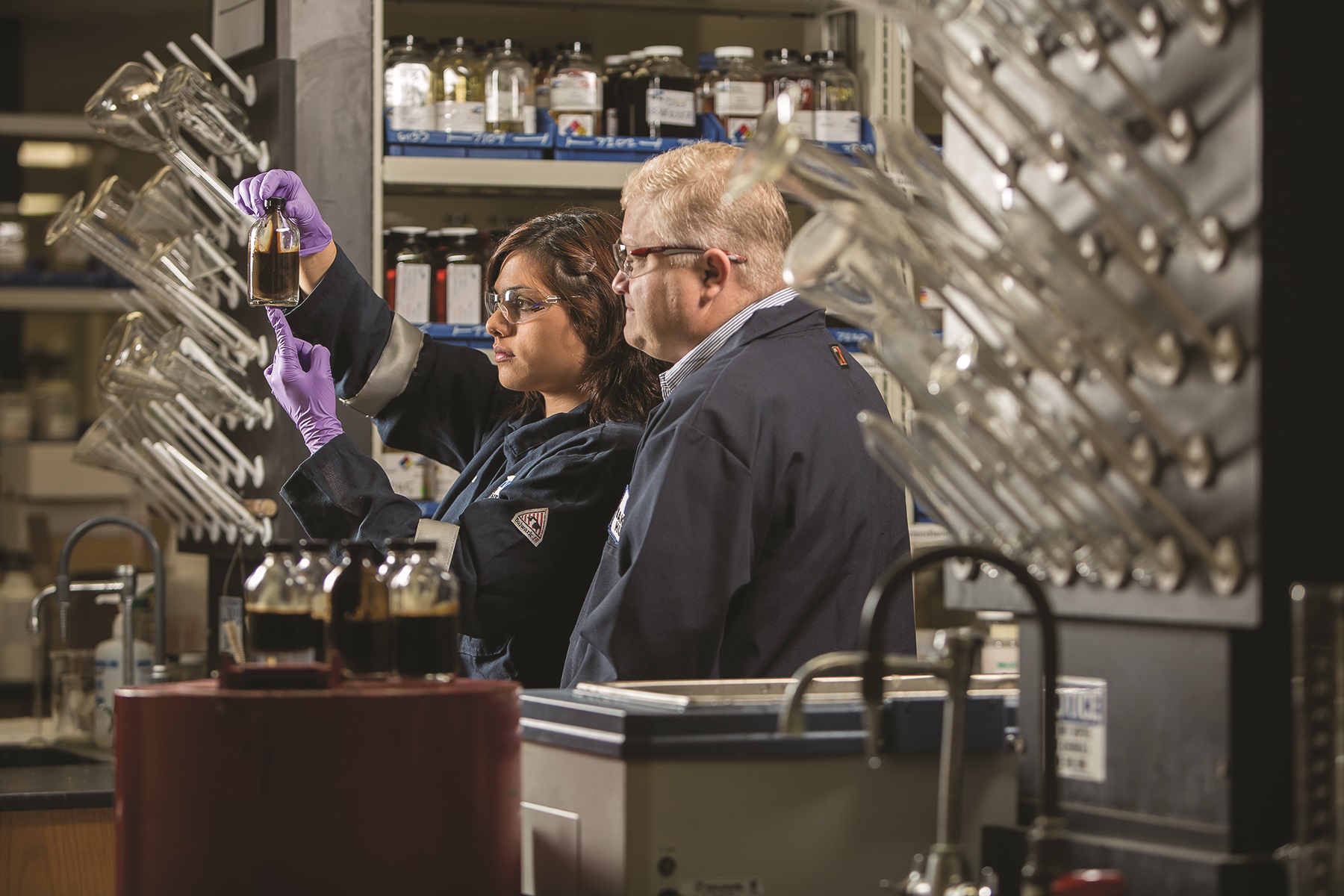
The collaborative process between chemical and artificial lift engineers builds on BHGE strengths in production chemicals, such as scale, corrosion and asphaltene inhibitors. (Source: BHGE)
Over the life of the well, electric submersible pumping (ESP) systems and production chemicals play significant roles in improving production performance, lowering lifting costs and generally enhancing well economics.
Individually, each discipline makes a distinct and vital contribution across a full scope of oil and gas wells. ESP systems help reduce lifting costs and optimize production to increase cash flow while production chemicals provide critical flow assurance and integrity solutions that maximize profits and extend asset life.
However, combining the two is difficult. While downhole chemistry obstacles are a leading cause of ESP failure, the industry has traditionally considered ESP technology and production chemicals as discrete, siloed solutions. This disconnect is a long-standing industry challenge with many barriers, from the complexities of data sharing to development of cross-discipline skills.
Recent efforts by Baker Hughes, a GE company (BHGE), are breaking down those obstacles to provide a more complete and responsive integrated solution to improve well performance.
The joint offering improves ESP run time, reduces workover activity, increases production and reduces lifting costs. Corrective action turnaround time is dramatically reduced by BHGE team analyses that more precisely identify the cause of any ESP failure, while simultaneously developing a more effective chemical program. Significantly, the improvements also are yielding new business practices to reduce expenses and downtime.
Integrating data and expertise
Integrating these resources promotes a new level of understanding and response to traditional well performance challenges.
The team approach joins both disciplines in a practical, application-oriented process that extends from a collaborative geographical information system (GIS) database to the investigative work on the ESP teardown floor to specific chemical program changes in the field.
The GIS database geographically matches current ESP installations with upstream chemical treatments as a decision-support tool cross-tied to ESP dismantle findings, chemical laboratory analyses, ESP failure histories, equipment setting depths and many other factors. GIS spatial analysis enables detailed mapping of data trends in a particular area, such as the occurrence of calcium carbonates in the Permian’s Wolfcamp Formation or iron sulfides in the Bone Springs Formation.
The resulting insights are a powerful guide to quickly understanding and responding to the current application and planning the next. The greater precision this GIS database affords in identifying geographic and geologic areas prone to organic and inorganic precipitation already is having a significant impact on ESP service life, well economics and production.
In the ESP teardown shop, artificial lift and chemical engineers analyze the cause of failures through a multifunctional team approach that zeroes in on specific corrective measures to be deployed in the field. This shoulder-to-shoulder teamwork amplifies the ESP solution with a faster, more precise ability to not only determine why the ESP failed but develop better-informed treatment options.

Analysis and prediction
The integrated process supports analysis and prediction of general solids characteristics by more closely associating pump conditions with various fields and formations. In this way, modeling is supplemented by real-world context gleaned from ESP teardown and inspection.
For example, a more thorough accounting of pressure- induced depositions in the ESP is refining the solution. ESP systems have a lower pressure at the intake, with hydrostatic pressure added through the various equipment stages. Different species of scale precipitate inside the system based on this pressure regimen; calcium carbonates may occur in one section of the pump and iron sulfides in another. Similarly, temperature changes along the ESP during its operation will impact organic formation.
This is difficult to recognize without inspecting the ESP system fully. Integrating chemical and artificial lift experts into a cohesive team has connected the process, resulting in a better understanding of how various pressures and temperatures affect scale precipitation. While scale modeling might typically use only bottomhole pressure and surface pressure data, this fine-tuning recognizes that pressures and temperatures can change significantly through the stages of the ESP system. Breaking down those parameters yields a better idea of what is happening inside the ESP system and how it affects the chemistry.
A better ability to predict what is going to happen in the field has an immediate benefit in extending ESP run time. For instance, in multistage hydraulically fractured wells producing from tight reservoirs, the integrated analysis revealed iron sulfide deposits on the ESP system. The fast identification led to chemical recommendations for chelating the iron (keeps the iron in solution), with a resulting increase in ESP life, and reduction in pulling costs and deferred production. Moreover, it has been found that more than one species of scale can precipitate inside an ESP system. Thus, a chemical “cocktail” may be in order.
In another instance, the integrated analysis found that simply running a capillary injection string with the correct chemical treatment does not always solve the problem. When ESP reliability engineers identified that barium sulfate continued to precipitate inside the pumps of several Delaware Basin ESP systems, the upstream chemical engineer used this evidence to lower cap strings.
These solutions might appear somewhat obvious in hindsight but, in fact, required a connected process to quickly and reliably make the analysis and recommendation.
Application and value
The broad value of the BHGE collaboration is clearly illustrated by an ongoing program in the Permian Basin. The operator was contending with ESP failures due to a complex array of chemical issues, including scale, asphaltenes, iron sulfide, barium sulfide and paraffin. GIS mapping of ESP and upstream chemical data identified strong failure trends across the asset. Team rootcause analysis of ESP failures further defined the challenge and led to an optimized chemical program to achieve a far-reaching scope of performance improvements.
The solution has extended ESP runlife by 30% and supported 50 additional ESP installations so far this year. The integrated team approach also facilitated a change in business models for the asset to an extended performance contact featuring penalties and bonuses applied to individual ESP run times based on causes of failure.
In Canada this integrated approach eliminated asphaltene fouling in ESP systems. The solution lowered lifting cost by $8/bbl and reduced ESP replacements by 80%, leading to an estimated $11 million in realized value.
Have a story idea for Operator Solutions? This feature highlights technologies and techniques that are helping upstream operators overcome their challenges. Submit your story ideas to Group Managing Editor Jo Ann Davy at jdavy@hartenergy.com.
Recommended Reading
Canada’s First FLNG Project Gets Underway
2024-04-12 - Black & Veatch and Samsung Heavy Industries have been given notice to proceed with a floating LNG facility near Kitimat, British Columbia, Canada.
Balticconnector Gas Pipeline Will be in Commercial Use Again April 22, Gasgrid Says
2024-04-17 - The Balticconnector subsea gas link between Estonia and Finland was damaged in October along with three telecoms cables.
Energy Transfer Asks FERC to Weigh in on Williams Gas Project
2024-04-08 - Energy Transfer's filing continues the dispute over Williams’ development of the Louisiana Energy Gateway.
Apollo Buys Out New Fortress Energy’s 20% Stake in LNG Firm Energos
2024-02-15 - New Fortress Energy will sell its 20% stake in Energos Infrastructure, created by the company and Apollo, but maintain charters with LNG vessels.
EQT CEO: Biden's LNG Pause Mirrors Midstream ‘Playbook’ of Delay, Doubt
2024-02-06 - At a Congressional hearing, EQT CEO Toby Rice blasted the Biden administration and said the same tactics used to stifle pipeline construction—by introducing delays and uncertainty—appear to be behind President Joe Biden’s pause on LNG terminal permitting.




